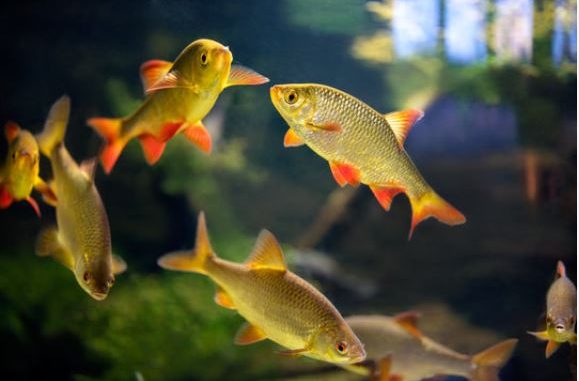
The bloodfin tetra is stunning to look at – a silvery-blue nano fish with an orange-red tail.
Native to South America, this species of tetra fish originates in the Paraná River basin. Preferring to hang out in the middle to top area in a home aquarium, bloodfin tetras are social schooling fish that appreciate hiding places.
They are a great choice for a community aquarium. We’ll look at everything you need to know about these fish, from appearance and behavior to optimal tank conditions and diet to keep your bloodfin tetra happy and healthy for years.
TABLE OF CONTENTS
Bloodfin Tetra Facts & Overview

| Category | Rating |
| Care Level: | Easy |
| Temperament: | Peaceful |
| Color Form: | Silver, red, blue |
| Lifespan: | 5-7 years |
| Size: | 1.5-2 inches |
| Diet: | Carnivore |
| Family: | Characidae |
| Minimum Tank Size: | 30 gallons |
| Tank Set-Up: | Freshwater with plants and rocks |
| Compatibility: | Peaceful community |
Measuring at 1 ½ to 2 inches, the Bloodfin Tetra, species characin, is on the longer side of the tetra spectrum. Also known as the Filigree Bloodfin Tetra or Glass Bloodfin Tetra, its scientific name is Aphyocharax anisitsi.
You might also see the Aphyocharax anisitsi advertised as True Bloodfin Tetra, Red-finned Tetra, Red-finned characin, or Argentine Bloodfin.
The Bloodfin Tetra is a robust fish that are easy to care for and great for community tanks. They are a great fish for beginning hobbyists as they are adaptable to slight variations in water chemistry, and as long as you give them a lot of swimming space and vegetation, they are easy to please.
They do well with slower-moving water, which mimics the conditions in their native South America. Aptly named, Bloodfin Tetras are unmistakable with their orangish-red fins and tail, which stand out against their iridescent bluish-silver body.
As a schooling fish, Bloodfin Tetras really add flair to a community aquarium when the group is swimming around the tank. they are so stunning that novices and experts alike enjoy the vivid coloration that Bloodfin Tetras add to the environment.
In a captive environment like your home aquarium, Bloodfin Tetras usually live for a period of 5 to 8 years, but sometimes we see them live up to 10 years.
Origin
The Bloodfin Tetra is found in the expansive Paraná River basin. The river itself spans 1,081,000 square miles (2,800,000 square km), running through Brazil, Paraguay, Bolivia, and Argentina. The Paraná River, or Rio Paraná, is the most expansive river in South America after the Amazon.
In addition to the Rio Paraná and the countries it flows through, Bloodfin Tetras are also native to the Amazon Basin and are seen in Colombia and Perú, so they can be found in nearly every South American country. Accustomed to acidic streams, rivers, and tributaries, Bloodfin Tetras enjoy the shade and lush vegetation, a preference that follows them to the home aquarium.
In the wild, Bloodfin Tetras are found in the upper and middle layers of the water, so it’s not surprising that they prefer the upper and middle aquarium waters, too. In their natural habitat, they mainly consume crustaceans, small insects, and worms.
Typical Behavior
Although bloodfin tetras are peaceful and social creatures, they tend to be more introverted if they are not together in a school–the group gives them added security and joy.
As we mentioned, their swimming preference is the top and middle part of the tank, as their natural habitat. However, jumping out of a home tank carries significantly more risk than jumping around in the spacious streams and rivers of South America, so it’s a good idea to have a tight-fitting lid on your home aquarium.
Bloodfin tetras are especially inclined to leap around during breeding time. They are active breeders who produce a lot but will also dine on their own young if given the chance; we’ll explore how to protect the developing Bloodfin Tetras in the breeding section of this article.
The Bloodfin Tetras are fast swimmers and are constantly moving, so expect a lot of activity from these Nanos.
Because they spend so much time swimming, and because they are schooling fish who thrive in a group of six or more, you’ll want to make sure you have a large enough tank, as they’ll nip at each other if they don’t have enough space.
Speaking of nipping, Bloodfin Tetras will go after slow swimming tank mates, especially those with long, nippable fins, if the tetras are not in the safety net of their school.
Appearance

Aside from their signature blood-colored tails and fins and iridescent bodies, there are some other important details about their appearance. They usually are about 1 ½ to 2 inches (3.8-5 cm) in length, but sometimes you’ll see one that’s 2 ¼ inches (5.5 cm).
The females are slightly larger and heavier than the males (they do carry eggs, after all.)
Females also have a first anal fin that is larger and has white beams. Mature males have gill glands and hooks over their anal fins.
As with many species, the male is more colorful than the female.
Habitat and Tank Conditions
Although Bloodfin Tetras are pretty tiny creatures, you do want to house at least 6 together, and because they are active swimmers, we suggest a minimum tank size of 30 gallons, especially if you have other inhabitants, too.
Make sure you acclimate your Bloodfin Tetras to the water and provide lots of plants and vegetation that reach to the middle and upper parts of the tank where they spend the bulk of their time.
The Bloodfin Tetra does great in cooler waters, but you may want to add a heater so that you can provide consistency so that they stay strong, stress-free, and healthy.
Tank Conditions
Water
Bloodfin Tetras will do well in both soft and relatively hard water (remember we said they were robust!), and do well with a pH in the 6.0 to 8.0 range, and intermediate water hardness, from 3-12 dGH.
The temperature range should stay between 70-80 F (21.11-26.67 C). As we mentioned, at this range, a heater isn’t vital but will provide consistency for your Bloodfin Tetras, which will decrease stress and encourage more vibrant coloring.
Water movement should be slow to moderate; they are accustomed to slow-moving waters in the wild but are also fast swimmers.
Optimal Tank Parameters
- Degree of General Hardness (dGH): 3-12
- General Hardness (Gh): 8 to 16
- Carbonate Hardness (Kh): 4 to 7
- Ph: 6.0 to 8.0
- Total Dissolved Solids (TDS): 180 to 250
- Temperature: 70 to 80 F (21.11-26.67 C)
Substrate and Habitat
The Bloodfin Tetra will appreciate a darker substrate that is reminiscent of their natural environment. A darker gravel and river sand will make them happy and also enhance their color.
Add some driftwood, rocks, twisted roots, dried leaves, and plants that will reach to the middle and the top of the tank so that the tetras have places to hide.
They prefer dim, filtered lighting, and don’t worry about overdoing the decorations and vegetation–what seems like excess to you will be like home in South America to them.
Just remember that all that dark substrate and plant life means you’ll have to clean the tank every couple of days. We’ll discuss later in the disease section why it’s so important to keep a clean tank.
Possibilities for habitat
- Artificial Plants: silk not plastic
- Cones: Alder Cones
- Leaves: Guava or Indian Almond
- Plants: bottom, floating, rosettes, and tall
- Vegetation: Java moss, aquarium weeds
- Wood: Malaysian or Mopani
Specific habitat considerations to ensure thriving Bloodfin Tetras:
Bottom Plants: Although we’ve mentioned numerous times that Bloodfin Tetras occupy the middle and top of the tank, it’s still important to provide them with some bottom vegetation, since that’s where they’ll be laying eggs. Anacharis and anubias are suitable choices.
Floating Plants: Water lettuce filters light so that the bloodfin tetras are not getting direct light. Watch for weeds and rot.
Hiding Places: Bloodfin Tetras may be social, but they also scare easily. They need plants, caves, and other decorations to give them plenty of places to duck out when they feel threatened or are being chased.
Lots of Swimming Space: We can’t stress enough the need for the Bloodfin Tetra to have room to swim. That being said, since they like lush vegetation and plentiful decorations, it’s even more important that you have a tank big enough to accommodate all that stuff and still allow the unencumbered swimming.
Tank Care
The Bloodfin Tetra is easy to care for provided its water is kept clean. Aquariums are closed systems and regardless of size, they all need some maintenance. Over time, decomposing organic matter, nitrates, and phosphate build-up, and water hardness increases due to evaporation. To combat these ever-changing conditions, water should be replaced on a regular basis. At least 25 to 50% of the tank water should be replaced every other week, especially if the tank is densely stocked.
What Size Aquarium Do They Need?
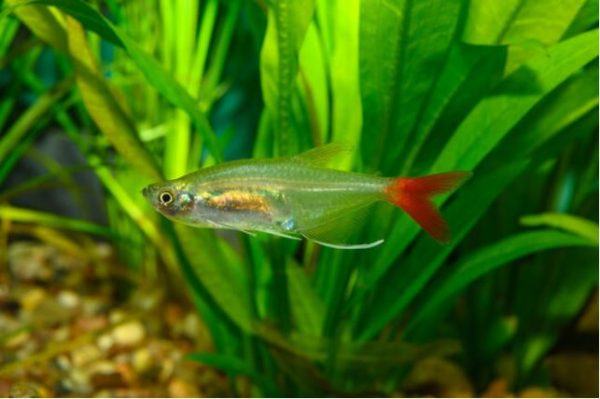
The tank needs to be big enough for water to move around and for the Bloodfin Tetra to swim freely. Since they do better in schools of at least six, you’ll need at least a 30-gallon tank, particularly if you have other inhabitants besides the Bloodfin Tetra.
In addition to the gallon parameters, you’ll want to make sure your tank is at least 20 inches long.
Tank Mates
Bloodfin Tetras are social and friendly with other tank inhabitants. they are perfect for community tanks. They have been known to nibble at the tails of longer-finned, slow-moving fish.
Bloodfin Tetras are peaceful fish and do well with other peaceful fish. They do well with fish that are not too much bigger than they are and that won’t threaten them. Matching them with other schooling fish of comparable size works well.
Suitable tankmates
- Cories
- Corydoras
- Crabs
- Danios
- Guppy
- Loricariids
- Platy
- Rasbora
- Shrimp
- Snails
- Swordtail
- South American dwarf cichlids
- Other tetras
Unsuitable tankmates
- Flowerhorn
- Jaguar cichlid
- Jewel cichlid
- Mini dovii
- Oscar fish
- Red devil cichlid
- Umbee cichlid
- Wolf cichlid
Keeping Bloodfin Tetra Together
Bloodfin Tetra is a schooling fish, so they need to be together. Not only are they happier and less stressed when they are in a group of at least 6, but life is also better for the Bloodfin Tetra’s tank mates when the tetras are schooled.
Angelfish and guppies, with their beautifully wavy fins, may be at risk of the bloodfin tetra’s nibbling, particularly if the tetras are not in schools.
If you have the Bloodfin Tetras in a school, you’ll see them swimming together in the middle and upper areas of the tank and mixing with other tank inhabitants.
If one of the tetras is bossier than the others, you might need to give him a time out and remove him from the tank to reduce stress on the rest of the group.
Diet
Bloodfin Tetras will eat flake food, but they like to eat what they have in the wild, so add worms, brine shrimp, daphnia, and frozen food to supplement and ensure the best nutrition.
Variety is key and they should get plants and vegetables in addition to meat.
Remember that Bloodfin Tetras are very active and so will need to eat a lot and more frequently since they are always burning calories they consume. We recommend following the 2-3 rule: 2-3 times a day and whatever they can eat within 2-3 minutes.
Don’t overfeed because they have no control and could get sick or die; also, whatever they don’t eat, you’ll have to clean rotting uneaten food out of your tank.
Appropriate Food List
- Blackworms
- Bloodworms
- Brine shrimp
- Cyclops
- Daphnia
- Flakes
- Frozen Food
- Pellets
- Spirulina
- Vegetables
Care

As we’ve noted, Bloodfin Tetras are a great starter fish since they are adaptable to different water conditions and are pretty resilient. If you follow the water, tank, and space recommendations we have detailed, you should have thriving Bloodfin Tetra.
It’s vital to keep a clean tank and watch your beloved tetras carefully for signs of disease — even though they are rugged, no one is immune.
Disease
Bloodfin Tetras are susceptible to skin conditions, parasites, and bacterial infections, as are most fish. If you keep a pristine aquarium, you significantly lower the risk to your Bloodfin Tetras.
Clean and quarantine all new additions to your aquarium, whether it’s a new inhabitant, plant, or decoration. Clean your tank regularly and check water conditions.
And of course, offer your Bloodfin Tetras a healthy diet to keep their immune system in optimal condition.
Because Bloodfin Tetras are sturdy creatures, it’s possible to mitigate and curb an outbreak of disease if you catch it fast.
The other thing to remember is that even when born in captivity, the Bloodfin Tetras have a proclivity for their native habitat, so anything you can do to recreate that (water temperature, substrate, vegetation, water flow, diet) will help them stay healthy.
Neon Tetra Disease
One disease that affects Bloodfin Tetras is Neon Tetra Disease. Some of the signs and symptoms are:
- bloating
- curved spine
- cyst
- difficulty swimming
- fin rot
- loss of color
- restlessness
A fish with Neon Tetra disease should be removed from the tank so that it doesn’t infect others.
Breeding
Bloodfin Tetras breed well in captivity and should be offered privacy when they are laying their eggs.
While they breed well, it does take some effort to successfully set the stage for reproduction. Before breeding, the males and females should be put in separate tanks and should be facing each other. Make sure they are getting the proper nutrition detailed above.
You’ll need yet another tank specifically for breeding. A nano tank will do for this one–10 or 15 gallons is sufficient. Place bushy plants or breeding mops along the bottom of the tank, and add a sponge filter to ensure water moves gently and that there is sufficient air.
While the ideal water temperature is similar (76-80 F or 24-26.6 C), you’ll need water that is a little bit softer than non-breeding times, with a pH of 6.5-6.8.
The pregnant female will appear so, with 300-500 eggs in her rounder body. When she spawns, she will leap as close to out of the tank as she can get, dropping her eggs in the tank. The Bloodfin Tetra eggs are not adhesive, and you’ll have to remove the adults after spawning so that they don’t eat their own eggs.
After a couple of days, hatching occurs, and the fry will get their nutrition from yolk sacs for a few days. You can also feed the fry infusoria or liquid fry food until they can handle nutrient-rich baby brine shrimp.
Are Bloodfin Tetras Suitable for your Aquarium?
After hearing all about Bloodfin Tetras, we think you’ll be convinced that they are a great fish with which to start your aquarium hobby. And for seasoned hobbyists, the Bloodfin Tetra may be just the addition you’re looking for. they are easy to care for and beautiful to look at.
It’s also fun to watch them swimming around in their school. they are robust fish, so beginners and children don’t need to worry too much about unintentionally harming them. they are also peaceful and social, so they’ll do well with other aquarium inhabitants.
Are Bloodfin Tetra your freshwater schooling fish of choice? Let us know why in the comments below…
FAQ

Where do Bloodfin Tetras originate from?
Bloodfin Tetras hail from South America, where they enjoy the estuaries, streams, and ponds of the Rio Paraná. They are also bred in captivity.
Are Bloodfin Tetras difficult to care for?
Quite the opposite! Bloodfin Tetras are quite resilient and rugged. They are amenable to a rather large range of water conditions, and as long as you keep their tank clean and provide them with spacious quarters for swimming, you should be able to enjoy them for years. They are known as one of the better fish for novice hobbyists, but experienced aquarists also enjoy their vivid colors and lively personalities.
Can I put Bloodfin Tetra in an aquarium with other fish, or do they have to stay by themselves?
Bloodfin Tetras are ideal for a community tank. they are social creatures, and they are peaceful (aside from the occasional nip at slower, long-finned fish!) As long as you don’t put them in a tank with larger fish that are likely to swallow them whole, Bloodfin Tetras are a great addition to your aquarium community.
Just remember to clean and quarantine any new tankmates, whether the new tankmates are the Bloodfin Tetras or other aquarium residents.
I used to have a betta fish and I know you can’t keep those together because they fight each other. Is it OK to put more than one Bloodfin Tetra in the same tank?
Not only is it OK, but we recommend it. Bloodfin Tetras are schooling fish and they do better in a group of 6 or more. The Bloodfin Tetras are social creatures, and they depend on the group for security and joy. Without the safety of the group, they can get a little high strung (like we all do when we are stressed out!)
In these situations, they are more likely to nip at other fish in the aquarium.
What area of the tank does Bloodfin Tetras prefer?
Bloodfin Tetras spend the bulk of their time in the middle and upper parts of the home aquarium since that’s the part of the water they prefer in their natural environment. Because of this, it’s fine to add bottom dwellers to the tank without disrupting the Bloodfin Tetras.
What kind of light should I buy for my Bloodfin Tetra?
These guys are accustomed to the shade of the South American river basin, so they do not like direct light. They should be fine with the natural light in the room, and the plants you add to the tank should filter the light for their comfort and preference. When they are breeding, make sure the light is dim.
Why do the Bloodfin Tetras like so many plants and decorations in the tank with them?
That’s a great question! There are a number of reasons:
- The Bloodfin Tetras’ native habitat in the rivers, streams, and basins of South America are lush with vegetation, rocks, and driftwood. Even Bloodfin Tetras that are born in captivity have a natural affinity for this kind of environment, so the more you can recreate that habitat, the happier they will be.
- Bloodfin Tetras, while social, are on the shy side, and need places to hide and chill out–we all need a break sometimes, right? The addition of plants, rocks, driftwood, cones, and decorations like caves and castles gives them the space they need to disappear for a while.
- When they are breeding, the Bloodfin Tetras lay their eggs on the tank floor (well, that’s where they land, anyway.) If there is a plant covering on the floor of the tank, the eggs have somewhere to rest until they hatch. The Bloodfin Tetras like rosette-style plants.
What should I feed my Bloodfin Tetras?
Bloodfin tetras are omnivores, so they need some meat in their diet. In their natural habitat, they eat crustaceans, small insects, and worms, so they need the nutrition from the meaty foods. You can feed them mainly a flake diet, but supplement with worms, frozen foods, shrimp, and insects.
They can also have some vegetables and spirulina. It’s good to keep in mind that a varied and high-quality diet will protect your Bloodfin Tetras from disease, prevent them from getting stressed out, and ensure that they have vivid coloration.
In terms of how often and how much to feed these tetras, remember the 2-3 rule: 2 or 3 times a day and as much as they can eat in 2-3 minutes. When you’re preparing your Bloodfin Tetras to breed, make sure they get a solid 3 meals per day.
What is the lifespan of a Bloodfin Tetra?
Bloodfin Tetras live an average of 5-8 years, but some have been recorded living for up to 10 years.
I want to breed my Bloodfin Tetras, and I know I have to separate the males and females before breeding them. How can I tell the difference between males and females?
The males are thinner and lighter than the females. Females have a larger first anal fin with white beams. Mature males have gill glands and hooks over their anal fins. The males are also more colorful than females.
What is the average size of the Bloodfin Tetra?
Bloodfin tetras are pretty small, measuring about 1 ½ to 2 inches (3.8-5 cm). That being said, they are some of the larger of the nano fish. We don’t recommend a nano tank for them since they love to swim and because they are schooling fish that do better in groups of 6. Therefore, they need a bigger tank. We recommend 30 gallons and 20 inches long to provide optimal swimming space.

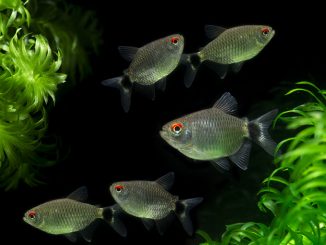
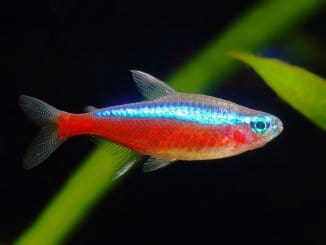
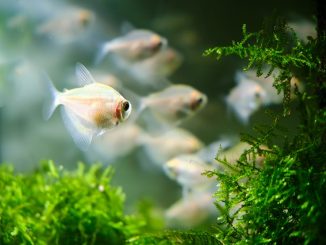
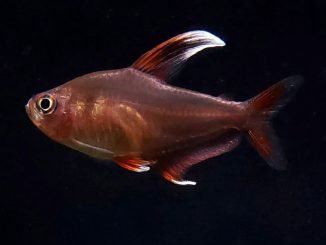
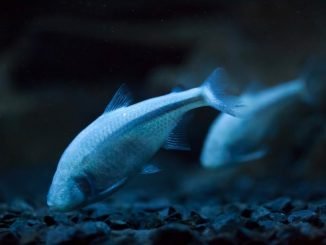
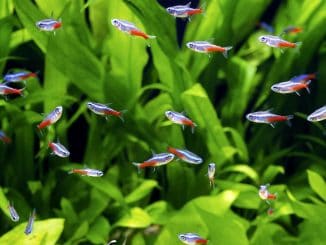
Be the first to comment